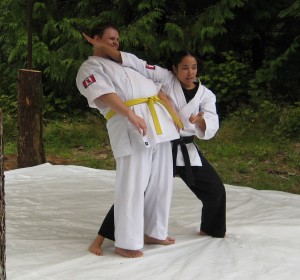3 Methods for Learning Martial Arts Techniques More Efficiently
Nov. 27, 2012 By: source http://pacificwavejiujitsu.com/blog/3-methods-for-learning-martial-arts-techniques-more-efficiently/
 “Practice
makes perfect”, or so we were led to believe when we were growing up.
“If you do something 10,000 times, you’ll be a master,” is another
similar saying. But this isn’t the whole story. That’s why my Sensei
always said, “Practice does NOT make perfect; perfect practice makes
perfect. Practice makes permanent.” In other words, if you practice a
thing 10,000 times wrongly you’ll have only mastered doing that thing
wrong, sealing the incorrect method into your muscle memory.
“Practice
makes perfect”, or so we were led to believe when we were growing up.
“If you do something 10,000 times, you’ll be a master,” is another
similar saying. But this isn’t the whole story. That’s why my Sensei
always said, “Practice does NOT make perfect; perfect practice makes
perfect. Practice makes permanent.” In other words, if you practice a
thing 10,000 times wrongly you’ll have only mastered doing that thing
wrong, sealing the incorrect method into your muscle memory.This is why it’s important to train your body to do a physical skill like a martial arts technique correctly as quickly as possible so that all your practice serves to reinforce that method, rather than reinforcing a method that is incorrect or inefficient, even if it feels more natural to you. There are methods of correcting technique to get yourself on track more quickly an efficiently, three of which I will outline in this article.
When You Make a Mistake, Over-Compensate
If you make a mistake, the worst thing you can do immediately after is to repeat exactly the same mistake. Doing this reinforces the incorrect method. most people will aim to do correct the mistake by aiming for the perfect method, but more times than not, it leads to making the same mistake but to a lesser extreme. This is better than exact repetition of the error, but it will tend to take more repetitions of aiming for perfection to make the necessary incremental adjustments to achieve it. This is because our bodies tend to want to default to the methods that feel natural to our bodies even if we know they are wrong in our minds.
To correct for this more efficiently, you’re better off over-compensating incorrectly to the opposite extreme. If you’re keeping your guard too low when you spar, bring them up to a position that’s too high on your next attempt. If your aim of a punch to solar plexus is landing too far to the right, aim to land too far to the left. Over-compensating to the opposite extreme will train your body to work outside what feels natural, helping it to correct more quickly and efficiently to the median of accurate placement.
To Learn Faster, Go Slower
When training at higher speeds, as we tend to want to do in the martial arts, it’s harder for you to detect your own errors. Your brain doesn’t have time to perceive the mistakes, whether it’s what’s you see or the way it feels in your body. When you practice a technique slowly, you’ll more easily notice incorrect hand position when doing a wrist lock or foot work when doing a takedown. This is one of the reasons why I encourage students to practice new or problematic techniques slowly without power, so they can be more aware of any errors and self-correct as necessary. Sometimes we’ll even use super-slow motion training for even higher levels if awareness. This can be great for times when you’re really struggling with a technique. Here is a blog post I wrote related to the topic of reducing speed when doing martial arts training.
Focus on a Strong Start and Finish
Sometimes slow motion training is impractical, like when you’re working on throws, jumping kicks, flying arm bars, etc. In these situations, you can instead focus on having a strong beginning position and ending position.
For a shoulder throw, you enter the throw with your feet shoulder-width apart, hips well below those of your training partner with your arms breaking their balance from their shoulder straight forward. Once your partner’s heels are lifted you can then follow through with the rest of the movement of the throw. A strong finishing position should be on balance with feet firmly in place with the body coming upright as your training partner hits the ground right in front of you. If their breakfall is on form, their legs should be pointing away from you. If your ending position is a little off the mark, correct it after the fact to train your body to be where you want it to be. By training a strong start and finish for any technique, the steps in between are more likely to correct themselves on the move in order to connect the mental dots you have established in your mind and body.
Combining Learning Methods
Sometimes I’ll run a class specifically focusing on one of the above approaches to learning depending on what my students are working on. But you don’t need an instructor to specifically direct you to use these methods in your training. I encourage my students to use these methods based on their own training needs. If they can learn to be their own teacher to some degree, thanks to sound training methods, they won’t always need to wait for an instructor’s attention to get the corrections they need. Of course, these methods won’t solve every problem and you still need an instructor’s expertise and objective eye to make subtle improvements and catch subtle errors, as you become better at what you do.
If you’d like to read more about these concepts, check out chapter 7 of Dan Millman’s Body Mind Mastery: Creating Success in Sport and Life
Do you or your instructor have other ways of helping learn skills more efficiently? Please feel free to share them in the comments.